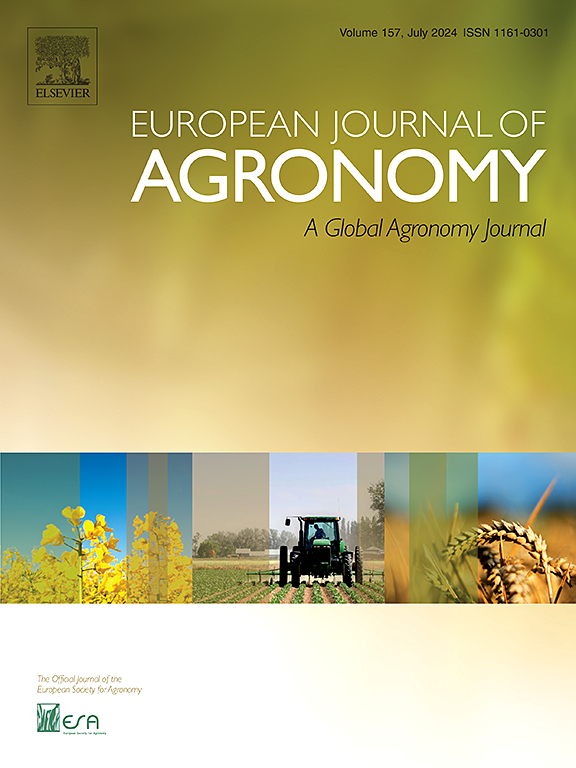玉米叶片缺氮检测与分类的植被指标研究
IF 4.5
1区 农林科学
Q1 AGRONOMY
引用次数: 0
摘要
氮是影响作物生长发育和产量的重要养分。因此,特定地点和最佳氮肥施肥需要了解空间氮分布和田间不足。光学方法测定叶片氮浓度(LNC)比实验室方法具有成本低、性能快的优点。与无人机(UAV)等一起,光学方法也可以用于获取高空间分辨率的LNC信息。因此,本研究的主要目的是确定最合适的植被指数来检测和分类玉米(Zea mays L.)氮素差异和缺氮。在控制光照条件下,获得了4种不同施氮量(0.72 ~ 2.88 g N/株)处理下全膨大玉米叶片450 ~ ~ 998 nm高光谱图像,并测定了相应的LNC。在此基础上,确定了归一化差分光谱指数(NDSI)和比值光谱指数(RSI)两种植被指数公式的最佳波长对。最后,通过反映LNC类型空间变化的模拟模式图,对已识别的植被指数和从文献中选取的植被指数对LNC进行预测和分类的性能进行了评价。结果表明,在红边区域(718 nm)的波长对LNC最显著(r = 0.92)。考虑的植被指数公式(NDSI和RSI)在红边和近红外波长对(722 nm, 950 nm)组合时表现最佳。两种植被指数均与LNC表现出较强的相关性(NDSI R2=0.90, RSI R2=0.86),在预测LNC种类及其在模拟格局图中的分布方面表现最好(准确率为91.7 %,kappa=0.87)。本文章由计算机程序翻译,如有差异,请以英文原文为准。
Vegetation indices for the detection and classification of leaf nitrogen deficiency in maize
Nitrogen is an important nutrient with respect to crop growth, development and yield. Hence, site specific and optimal nitrogen fertilization requires knowledge of spatial nitrogen distribution and deficiencies in the field. Optical methods to determine leaf nitrogen concentration (LNC) have advantages over laboratory methods because of lower costs and faster performance. Together with e.g. unmanned aerial vehicles (UAV), optical methods can also be used to acquire LNC information with high spatial resolution. The main goal of this research was therefore to determine the most suitable vegetation indices for the detection and classification of nitrogen differences and deficiencies in maize (Zea mays L.). Hyperspectral images from 450 nm to 998 nm of fully expanded maize leaves from four different nitrogen treatments (0.72–2.88 g N/plant) were acquired under controlled light conditions and the corresponding LNC were determined. Then optimal wavelength-pairs for two predefined vegetation index formulas, the normalized difference spectral index (NDSI) and the ratio spectral index (RSI), were identified. Finally, the performances of the identified vegetation indices and selected vegetation indices from the literature to predict and classify LNC were assessed by means of a simulated pattern map that reflects spatially varying LNC classes. It was found that a wavelength from the red edge region (718 nm) was the most significant for LNC (r = 0.92). The vegetation index formulas considered (NDSI and RSI) showed the best performances when wavelength-pairs from the red-edge and NIR region (722 nm, 950 nm) were combined. Both vegetation indices showed a strong relationship with LNC (R2=0.90 for NDSI, R2=0.86 for RSI) and performed best at predicting LNC classes and their distribution in the simulated pattern map (accuracy=91.7 %, kappa=0.87).
求助全文
通过发布文献求助,成功后即可免费获取论文全文。
去求助
来源期刊

European Journal of Agronomy
农林科学-农艺学
CiteScore
8.30
自引率
7.70%
发文量
187
审稿时长
4.5 months
期刊介绍:
The European Journal of Agronomy, the official journal of the European Society for Agronomy, publishes original research papers reporting experimental and theoretical contributions to field-based agronomy and crop science. The journal will consider research at the field level for agricultural, horticultural and tree crops, that uses comprehensive and explanatory approaches. The EJA covers the following topics:
crop physiology
crop production and management including irrigation, fertilization and soil management
agroclimatology and modelling
plant-soil relationships
crop quality and post-harvest physiology
farming and cropping systems
agroecosystems and the environment
crop-weed interactions and management
organic farming
horticultural crops
papers from the European Society for Agronomy bi-annual meetings
In determining the suitability of submitted articles for publication, particular scrutiny is placed on the degree of novelty and significance of the research and the extent to which it adds to existing knowledge in agronomy.
 求助内容:
求助内容: 应助结果提醒方式:
应助结果提醒方式:


